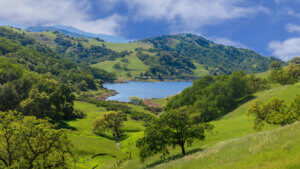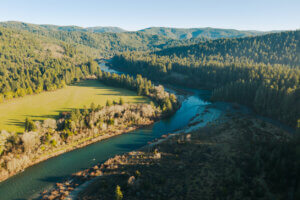Students visiting the Jack and Laura Dangermond Preserve embark on a transformative journey as they experience one of the last places along the California coast that hasn’t been disrupted by commercial development. Along the way, they are greeted by the watchful eye of an osprey soaring overhead, a sentinel of this untouched wilderness. In 2017, The Nature Conservancy purchased the 24,000-acre coastal preserve with a generous $165 million dollar donation from Jack and Laura Dangermond.
The area, known formerly as Bixby Ranch and often referred to as “The last perfect place in California,” is home to fourteen endangered species and much of the state’s biodiversity. Acquiring and protecting the property has been a top priority for conservationists for decades.
Since The Nature Conservancy’s acquisition, the Preserve has become a beacon for education and scientific research. The Preserve’s location positions it at a unique convergence of four eco-regions and seven habitats—presenting scientists with the opportunity to study a climate-resilient ecosystem.
“The Preserve has become a living laboratory where we conduct research and run environmental education programs that are critical to building a sustainable future for our planet,” says Diego Ortiz, environmental education program manager with The Nature Conservancy. “We’ve also just completed our first translocation project, where we were able to bring back a species that used to be found along the coast of California. With a number of restoration projects underway, the Preserve is a perfect hub for us to build an education model that we could later expand.”
Connecting with Nature and Community
Born in El Salvador, Diego Ortiz immigrated to the United States with his family when he was two years old as a refugee of the Salvadoran Civil War. With little in their possession, Diego’s family turned to the abundance of nature, and through annual visits to the area’s national parks, such as Yosemite National Park, Joshua Tree, and the Grand Canyon, Diego’s passion for connecting with nature was born.
Before joining The Nature Conservancy, Diego worked as the director of youth programs for Pacoima Beautiful, an environmental justice nonprofit serving the San Fernando Valley. It was there that Diego worked with youth in Pacoima, Sun Valley, Arleta, and the City of San Fernando to garner collective action to identify and address issues of concern for area youth. In 2021, Diego joined The Nature Conservancy, bringing his years of experience with youth environmental justice to help expand partnerships between the new Preserve and local school districts. Diego’s background uniquely qualifies him to address some of the systemic challenges facing the local community surrounding the Preserve.
A report from The City Project CA found that despite Santa Barbara County’s hundreds of green spaces, data shows that “areas in the county with the most people of color, highest rates of poverty, and worst access to cars also have the worst access to parks.” The report also found that communities with a higher Latino population had disproportionately less acreage dedicated to green spaces compared to areas with a majority white population.
Nested in the community of Lompoc, The Nature Conservancy’s Jack and Laura Dangermond Preserve aims to leverage its partnership with local schools toward creating more equitable access for the city, which is majority “Hispanic or Latino,” according to the U.S. census. In 2022, The Nature Conservancy officially launched its programming to bring students from the Lompoc Unified School District to the Preserve.
“In comparison to other areas in Santa Barbara County, the disparity in access to green spaces for students in Lompoc is significant,” says Diego. “We want to be intentional with the communities that we work with, so we began with the Lompoc community for a reason. With our day program, seventh graders from the district get to visit the Preserve. And while the students are out on the field with us, they are learning about the various ecosystems that exist on the Preserve, how it’s a sanctuary for wildlife, and how the land and ocean interact.”
A Tether to the Past and the Future
For students, visiting the Preserve is a rare opportunity to experience a pristine California coast untouched by commercial development. As they traverse the Preserve, the landscape transforms from coastal sage scrub to groves filled with weathered oak trees to crumbling ocean bluffs. The distant crash of the Pacific Ocean against the nearby cliffs alerts them to the sandy beaches close by. During their field trips, students learn more about the unique ecosystems at the Preserve and the local wildlife that flourish in the area. They also learn about how the land and ocean interact and practice their science skills in groups—fostering connections with their peers and with the land.
Beyond just being a look into the past of California’s coast, the Preserve is also a doorway into the future. During their field trip, students get to meet with the scientists who are studying the landscape in an effort to advance research on adapting to climate change. The Nature Conservancy has developed research partnerships with more than twenty institutions, including NASA, the Smithsonian Institute, and UC Santa Barbara, which involves managing the access of graduate and undergraduate students engaged in research and study of these last remaining coastal ecosystems. The property’s connected natural systems and undisturbed habitats along the Southern California coast is the last stronghold of the state’s coastal wilderness. The Dangermond Preserve’s unique role in the cultural and biological landscape means it will be managed and studied in a way to guide future conservation efforts.
Crucial to Diego’s efforts to expand the environmental education programming at the Dangermond Preserve has been CAELI’s statewide network of environmental education leaders and community-based partners. “CAELI has been instrumental in helping us connect to resources within Santa Barbara County,” says Diego. “The CAELI network helps us understand the environmental education landscape in the state and helps ensure that our educational programs have more of an impact. CAELI has supported our efforts to learn from other organizations from across the state and identify where the greatest needs are.”
The program’s success at the Dangermond Preserve has paved the way for expansion. With a long-term goal of expanding to three more preserves across the state by 2030, The Nature Conservancy hopes to take their impact statewide with immediate plans to increase the number of participating students to 750+ in the 2023-24 academic year.
To keep up with their work, visit their website and learn more about their programs.






